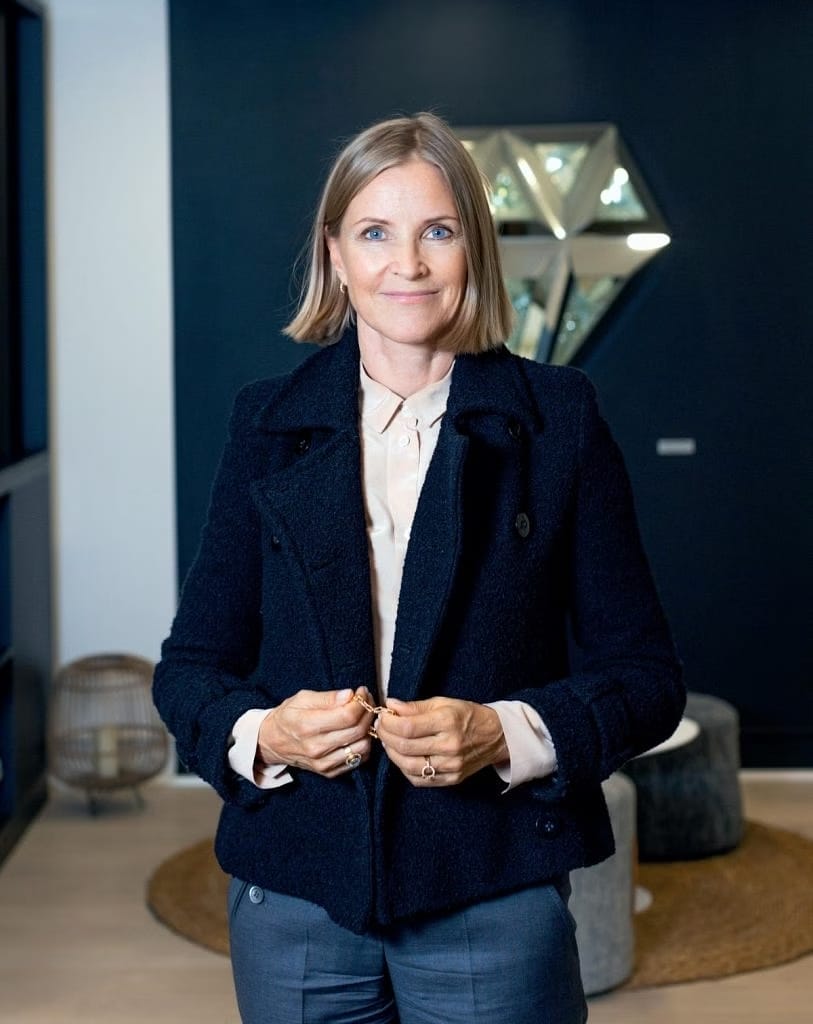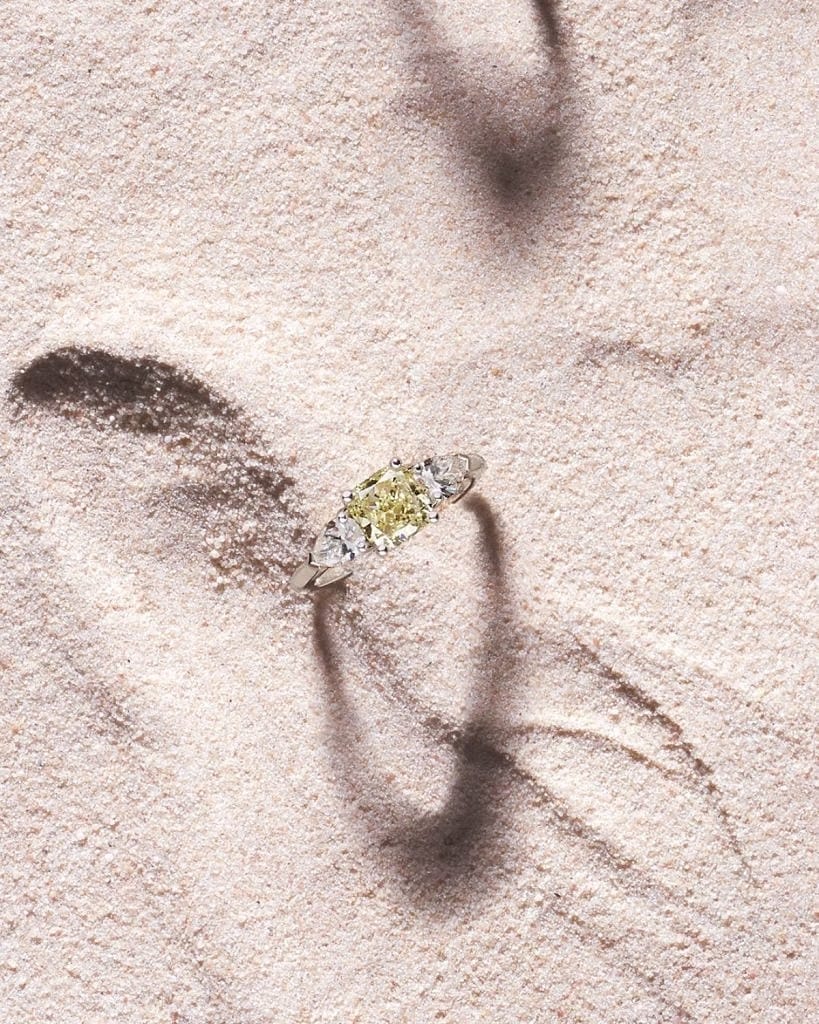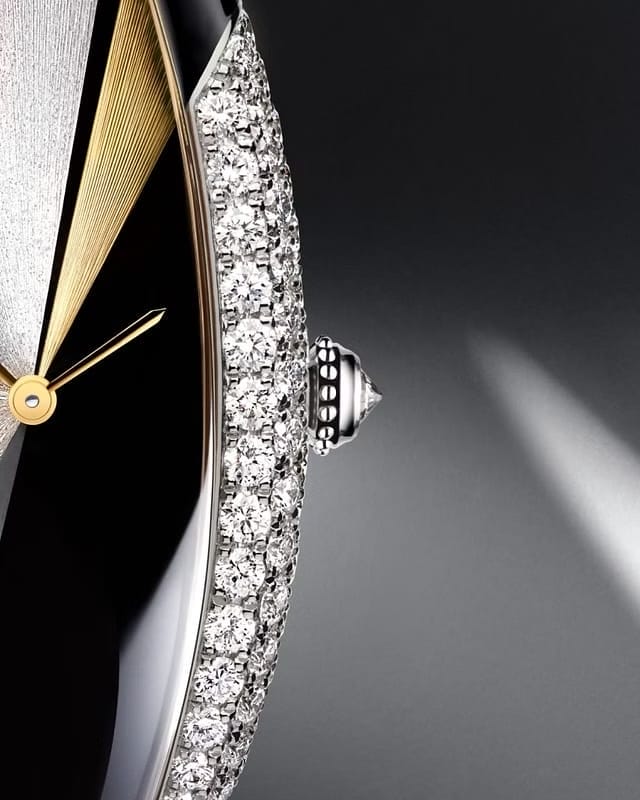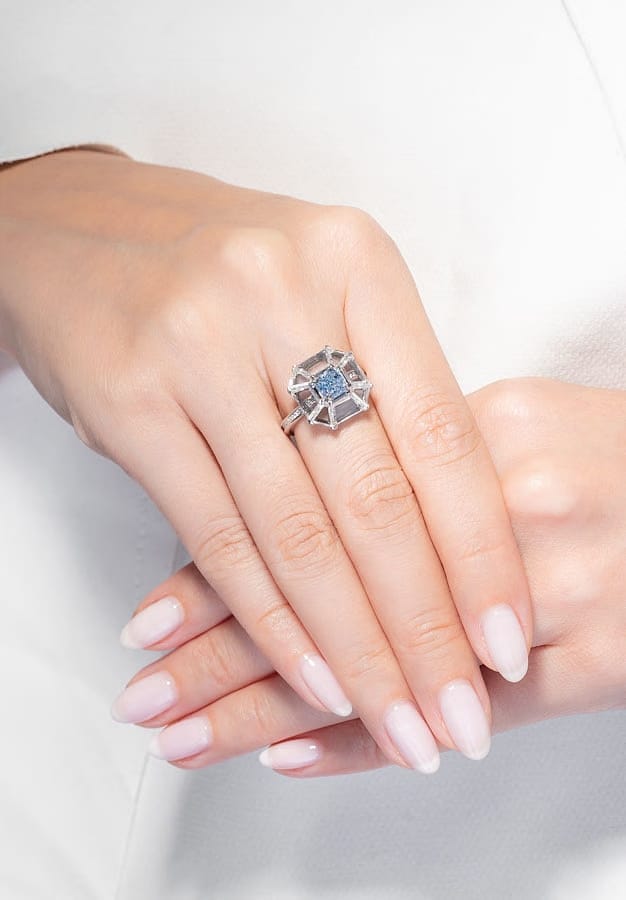by Yanni Tan

“Now is the time to buy real diamonds,” says Tay Kunming, gemologist and director of Far East Gem Lab. Recent global prices of polished mined diamonds have tumbled to the lowest in the past decade, as the International Diamond Exchange reported. Over the past few years, this decline is attributed to various complex factors resulting in what Tay terms “a perfect storm”.
During the Covid lockdown, explains Tay, mining halted, factories shut, and workers moved to other sectors — resulting in a labour and product shortage. However, consumer demand was buoyed by pent-up spending desire.
The opportunity was ripe for lab-grown diamond jewellery companies, which have been around for decades, to capitalise on the situation. When fine jewellers and traders were restricted from doing in-person business, as is the norm for such precious goods, lab diamond firms and retailers launched aggressive marketing campaigns and sold online, especially the smaller stones destined for solitaire rings.


Immediately post-pandemic, consumers continued to splurge on luxury goods but began to prioritise travel and experiences. This trend, along with the increasing popularity of cheaper lab-growns and Russian natural diamonds flooding the market, started to shake things up — the impact of which hit in early 2023. A precipitous price drop for mined diamonds ensued with the onset of the Russia-Ukraine war, economic uncertainty and sudden interest rate hikes.
The natural diamond industry is currently rallying for recovery. It expects prices to self-correct within the next one to two years, as forecasted by the Diamond Exchange of Singapore (DES). After all, while prices of these mined stones have fluctuated over the last 35 years, they have risen by 3 per cent per annum on average.
However, one of its biggest long-term challenges would be the exponential growth of lab diamonds and its cannibalisation of market share.
As a comparison, a one-carat round lab diamond, VS in clarity, was 16.6 per cent cheaper than a mined one in 2016, as Paul Zimnisky Diamond Analytics reported. By January 2023, lab stone had become 74.6 per cent cheaper at US$1,430 compared to US$5,635 for a natural stone.
Towards the end of last year, the per-carat price of the lab diamond had dipped to US$800, says the DES, which expects this figure to fall to US$300 this year.
Meanwhile, Allied Market Research forecasts lab-growns’ market size to reach US$55.6 billion by 2031, up from US$22.3 billion in 2021, with a compound annual growth rate of 9.8 per cent from 2022 to 2031. Statistica projects the lab-growns pie of the global diamond market to hit 10 per cent in 2030. Asia-Pacific, boasting rising disposable incomes and interest in luxury, is said to be a significant growth driver.
A status quo challenged
Still, whether they are described as man-made, cultured, brand-created or synthetic, lab diamonds are not fake. They are chemically, physically and optically identical to natural ones. In a landmark announcement in 2018, the US Federal Trade Commission (FTC) declared that they could be marketed as diamonds — the basis for which is that lab diamonds are grown by combining carbon atoms in a crystal lattice, just as in nature.
However, FTC cautioned that publicity statements must qualify their lab origins.
Today, what took the earth one to over three billion years to form under extreme pressure and heat now takes a few days to several weeks. The two main methods are High Pressure, High Temperature (HPHT), which is a costlier technology that uses sizeable industrial pressure chambers to crystalise carbon around a diamond seed, and Chemical Vapor Deposition (CVD), a more widespread process that uses more compact, lower-pressure reactors in which microwaves strip carbon atoms from a hydrocarbon gas, and layer them onto a seed diamond plate.






Lower price points aside, proponents have touted various advantages of such stones, which won over many consumers, especially the younger ones.
Lab diamonds are said to be free from ethical and human rights complications historically associated with natural diamonds, which could originate from conflict zones that mined “blood diamonds”. And while the African civil wars in question happened in the late ’90s and have mainly been resolved, the sale of Russian diamonds, believed by some to be funding the war against Ukraine, has recently become a matter of contention.
Lab diamonds are also purported to have a low environmental and carbon footprint. However, a recent global greenwashing crackdown has caught up with some of these marketing claims, which can only be substantiated by firms operating at the highest standards.
Still, the stats put out by the “for” and “against” camps can be contradictory. Not all lab diamond producers are green or socially responsible, and most of such diamonds are manufactured in China and India and mainly use electricity generated by fossil fuels. European producers, especially those that use renewable energy like wind power, fare much better in their carbon footprint.
The real cost of mining
Countering charges that certain lab diamond makers can be highly pollutive, Marie-Ann Wachtmeister, co-founder of Place Vendome-based Parisian eco-jeweller Courbet, opines that all things considered, lab diamonds are still less harmful to the environment.


Marie-Ann Wachtmeister, co-founder of Courbet. (Photo: Courbet)
Questioning the veracity and scope of market studies funded by mining giants, she says, “Everybody’s talking about carbon dioxide emissions, but an important element is the impact of land destruction on biodiversity. A mine could be 75 per cent the size of Paris. It takes 20 years to extract diamonds equivalent to half a bathtub, and when they close the mine, it’s abandoned. And despite what some say about their commitment to putting back every stone, every tree, it’s simply impossible to refill a hole that big.”
Furthermore, she asks, “Do these reports calculate the impact of producing the dynamites used to open up mines?”
A pioneering champion of lab diamonds since its launch in 2018, Courbet creates stones through Diam Concept, a CVD-method production facility it owns in France. For what it cannot make, it sources ethical diamonds in a “cascade” pattern, starting with solar-powered firms in the US and going down to the next level of suppliers.
For Courbet, to ensure that its diamonds are certified sustainable by industry authority SCS Global Services, it has recently undergone a full third-party audit to assess and improve its sustainability and social responsibility measures.






For 2021, its carbon footprint was 352 tonnes — a 1-carat cut diamond produced by Diam Concept emits 20kg of carbon dioxide emissions (the natural diamond averages 108.5kg, as reported by Imperial College London in 2021), and it aims to achieve a neutral environmental footprint by 2028.
Supply chain transparency is another hallmark of lab diamonds, adds Wachtmeister. “There are 12 intermediaries between the mining company and the consumer for natural diamonds, whereas, for lab diamonds, there is one. All that margin for lab stones has been compressed, and that’s why prices have gone down.”
“How can one even suggest that the two are comparable?”
SURESH HATHIRAMANI, VICE-PRESIDENT OF THE DIAMOND EXCHANGE OF SINGAPORE (DES) BOARD ON NATURAL VS LAB STONES.
Lab diamonds also allow for a brave new world of customisation and experimentation. Already, Courbet has made an array of colours, from cognac and blue to pink and yellow.
“Six years ago, it was not possible to get green, but now we have some nice ones. In the coming ten years, we will see innovations we can’t imagine today — colours like red and violet, and crystallising shapes not found in nature, such as cylinders, that help jewellers explore new creative fields.”
A luxury adoption
For a long time now, the topic of lab diamonds has been polarising — and taboo — among major luxury players that have traditionally remained resistant to the idea and tight-lipped about their views.
Naturally, independent and mass brands were the first movers in adoption.


A Courbet ring in white gold and yellow. (Photo: Christophe Bouquet)
Austrian crystal companies Swarovski and Pandora began rolling them out in 2016 and 2021, respectively, while a growing number of small jewellers have jumped aboard over the past few years.
Some independents like Courbet, especially in Europe and the US, proudly dedicate their entire inventory to such cultured stones. Such commitment pays off — in February 2021, French watchmaker Barillet featured Courbet-supplied diamonds in its first batch of 10 Superpunk Diamants Lab Experience timepieces, which sold out in three weeks.
Those who thought the legacy sphere would be impenetrable have been proved wrong. It was widely reported that Chanel Corp had taken a 13 per cent stake in Courbet in 2021. Still, Wachtmeister would tell us that the luxury giant was one of its founding investors.
The Chanel brand, however, stated in a written statement to The New York Times then that it wasn’t planning to use them in its products.
As a sign of more things to come, luxury powerbroker LVMH Luxury Ventures acquired a substantial stake in Israeli solar-powered lab-diamond grower Lusix in 2022.


The Tag Heuer Carrera Plasma Diamant d’Avant-Garde Chronograph Tourbillon. (Photo: Tag Heuer)
This news came just as one of its brands, Tag Heuer, threw down the gauntlet at the trade show Watches & Wonders Geneva by debuting the Carrera Plasma Diamant d’Avant-Garde Chronograph Tourbillon 44mm, which features three CVD-made polycrystalline diamond plates and 121 large lab-grown sparklers. The Carrera Plasma Diamant d’Avant-Garde 36mm bearing pink lab-growns followed this creation last year.
In the interim, Breitling showcased Type IIa single-crystal diamonds on its new Super Chronomat Automatic 38 Origins model and announced that by 2024, it would have completed a transition to lab-grown diamonds across its entire product portfolio. Oris then followed with the Aquis Date Diamonds last April.
Watchmakers, in their quest for innovation and experimentation, aren’t the only ones dabbling with lab diamonds.
Just last October, Prada premiered such stones in its sustainable Eternal Gold fine jewellery collection, stating that it was focused on pushing boundaries. Before this, the historical Parisian maison of Fred, now owned by LVMH, had also recently flaunted Audacious Blue lab diamonds complemented by natural white diamonds in the Force 10 Duality high jewellery collection.
However, its artistic director, Valérie Samuel, a third-generation executive of the founding family, says that the large blue lab rocks are meant to replicate the house’s signature Riviera blue, which is impossible to find in mined diamonds. The brand does not plan to introduce other lab-growns for now.
A case for the incumbent
The FTC still prohibits the use of the words “real”, “genuine,” “natural,” and “precious” in lab diamonds’ marketing to differentiate the two types. It is their differences that the natural diamond industry is emphatic about.
Suresh Hathiramani, vice-president of the Diamond Exchange of Singapore (DES) board, states, “One is a naturally occurring rare mineral limited in supply, formed deep within the earth’s core over a period of a billion or more years. The other is produced in less than a week in a factory, available to order in the size and colour of your choice with a rapidly diminishing value. How can one even suggest that the two are comparable?”
Indeed, the place of diamonds in human culture is deep and symbolic — and we’re not just talking about DeBeers’ wildly successful “A Diamond Is Forever” campaign launched in 1948.






Traded in India as early as the fourth century BCE, diamonds were treasures that denoted power and wealth. Worn by ancient rulers and nobility, they were awe-inspiring status symbols that ordinary folk could only dream of.
The finest rocks known in history were large, flawless, “white than white” Type IIa Golconda diamonds mined from modern-day Hyderabad — so rare that it would be a treat for collectors today to see these old stones. The legendary 105.6-carat Koh-i-Noor, belonging to the British crown jewels, is one of them.


The Koh-i-Noor set in the Crown of Queen Alexandra, the wife of Edward VII. (Photo: Wikipedia)
We can trace the origins of the modern diamond industry to 1477, when an Austrian archduke commissioned the very first diamond engagement ring, igniting a trend among European elites. In the past five centuries, these rocks have become more affordable and democratised, and their significance has evolved to represent love and eternity as family heirlooms and objects of great sentimentality and financial value.
Another significant contribution the multi-billion-dollar diamond industry has is to livelihoods in the global supply chain, as well as the sustenance of local communities. Hathiramani adds, “Over 20 million people directly or indirectly live off the earnings from the mining and manufacturing of the natural diamond in countries where they are legally and ethically mined and polished.”
A push for conflict-free
Much has also been done in the past two decades to right the wrongs incurred in mining natural diamonds.
Established in 2003, the Kimberley Process Certification Scheme has successfully prevented “conflict diamonds” from entering the mainstream rough diamond market and improved transparency and accountability in the diamond supply chain. Working in tandem, the World Diamond Council traces the movement of rough diamonds from the mines to the polishing factories and helps keep conflict diamonds out of the trade.


Tiffany & Co. Tiffany Soleste cushion-cut natural yellow diamond halo platinum engagement ring. (Photo: Tiffany & Co.)
Maintaining that an overwhelming majority of natural diamonds are legitimate, Hathiramani elaborates, “Based on 2019 figures, only 0.8 per cent of the world’s diamond supply can be deemed to be of conflict origin. Strife and civil war have largely subsided, and peace has returned to countries such as Angola, Sierra Leone and Congo in Africa.”
“This amount,” Hathiramani adds, “equates to one million carats out of 130 million carats in worldwide production being effectively kept out of the legitimate diamond pipeline.”
This January, the G7 commenced sanctions against Russian diamonds to stop profits from flowing into the Kremlin’s war chest.
Calling out the negative perception of colonialism and corruption of large-scale diamond miners as outdated, a report from third-party researchers commissioned by the Natural Diamond Council cites that many of its members are already working on improving the lives of diamond mining communities and focusing on stewardship in line with the UN Sustainable Development Goals. It further highlights that these companies must abide by strict global, national and industry regulations.
The Responsible Jewellery Council, formed in 2005, also brings together over 1,800 companies of all sizes across the global watch and jewellery supply chain, from retail to mining, to establish, uphold and boost sustainability standards. Firms like De Beers Group are committed to becoming carbon-neutral by 2030, while Rio Tinto aims to achieve net-zero emissions by 2050.
Enter the watchmakers
When comparing natural and lab diamonds’ physical properties, the Gemological Institute of America (GIA) states that both appear identical to the unaided eye, with advanced testing required to identify lab-made stones based on their specific growth-related features and patterns.
While colourless diamonds, regardless of origin, appear similar, gemologist Tay, who also runs a training school and jewellery boutique, says that experts can pick out coloured lab diamonds: “Their colours tend to look unnatural.”


Cartier Jewelled Tank large model watch in rose gold, amethysts, coral, chrysoprases and natural diamonds. (Photo: Cartier)
Technicalities and ESG credentials aside, the real test for lab diamonds is whether or not the public will ever regard them equally as their natural siblings. For people who play in the collectible luxury segment, natural diamonds of high quality and strong provenance will always retain their prestige.
A groom-to-be buying an engagement ring could get a larger lab diamond for the same budget, but is the bride eco-conscious, and how will she feel about it when prices fall? If you wear a statement rock on your finger, will you be comfortable or thrilled admitting it is lab-made?
Adoption may be easier amongst watch enthusiasts. Prominent local watch collector Bernard Cheong, who has served as a juror at the prestigious Grand Prix d’Horlogerie de Genève, feels that lab diamonds will find easy acceptance among horology purists.


Cartier High Jewellery Baignoire Allongée watch in white and yellow gold with onyx and natural diamonds. (Photo: Cartier)
“The great thing about lab diamonds is that they are not limited in supply, and you can get the best cut, colour and clarity. Watchmaking is about uniformity, and so it’s just more practical to use lab diamonds. At the end of the day, whether the diamonds are natural or not doesn’t factor into the price of a timepiece — it’s the amount of effort that it takes to manufacture it, including setting the stones, which is a very labour-intensive and expensive process,” says the medical doctor, who also collects diamond watches.
Cartier, Rolex, Harry Winston and Audemars Piguet are some brands that use the brightest, whitest natural diamonds. Matching this quality, he thinks, is a challenge for some other brands.
“The LVMH guys really know what they’re doing. I predict there will be wider adoption of lab diamonds by watchmakers in less than five years.”
“Lab diamonds can finally be attainable by lower-income families in countries like India, where they are culturally important.”
VIHARI PODDAR, FOUNDER OF VIHARI JEWELS
A clear winner
The rise of lab diamonds looks inevitable. What’s clear enough is that this category is currently carving out new segments of very different shoppers: individuals who could not have afforded natural diamonds nor wanted to stump up the cash and the affluent who support innovation and new perspectives in luxury.
Young local jeweller Vihari Poddar, founder of Vihari Jewels, who hails from a gem-trading family, concedes that introducing sustainable lab diamonds to her offerings had crossed her mind, but ultimately, she decided against it.
“Natural diamonds are a gift to humankind, and I’m always in awe of Mother Earth. Still, lab diamonds can be pitched as a dream to some. They can finally be attainable by lower-income families in countries like India, where they are culturally important,” she adds.


Vihari Jewel’s Art Deco ring features portrait cut diamonds surrounding a cushion cut Fancy Blue Diamond. (Photo: Vihari Jewels)
Asserting that lab-growns cannot possibly be regarded as luxury and highlighting the shuttering of many such US retailers last year, Hathiramani adds, “Lab-grown diamonds are the preferred gemstones for use in entry-level and fashion jewellery because of their ever-declining prices and corresponding affordability.”
The fact that some heritage brands have already opened the floodgates and that Courbet has been followed by close to 30 eco-jewellers entering the market in France challenges this view. This upstart industry may soon become segmented since not all lab diamonds and the jewellers offering them are equal.
Wachtmeister also points out that for such a high-tech manufacturing process requiring highly skilled labour and constant experimentation, there is a price floor for the products — and she predicts the figures are probably not getting much lower than where they are now.
As we wait with bated breath on how the future pans out, one thing is sure: The winners in the war for diamond dominance are you and me — the consumers.

